Geochemical Contamination, Speciation, and Bioaccessibility of Trace Metals in Road Dust of a Megacity (Guangzhou) in Southern China: Implications for Human Health
Abstract
1. Introduction
2. Materials and Methods
2.1. Study Site, Sampling, and Analysis
2.2. Trace Metal Contamination Assessment
2.3. Sequential Fractions and Bioaccessibility Assessment of Trace Metals in Road Dust
2.4. Human Health Risk Assessment and Monte Carlo Simulation
3. Results
3.1. Contamination, Enrichment, and Ecological Risk of Trace Metals in Road Dust
3.2. Sequential Chemical Species of Trace Metals in Road Dust
3.3. IVG Bioaccessibility Analysis of Trace Metals in Road Dust
3.4. IVG Bioaccessibility-Based Health Risk Assessment Using Monte Carlo Simulations
4. Discussion
5. Conclusions
Supplementary Materials
Author Contributions
Funding
Institutional Review Board Statement
Informed Consent Statement
Data Availability Statement
Acknowledgments
Conflicts of Interest
References
- Hou, S.; Zheng, N.; Tang, L.; Ji, X.; Li, Y.; Hua, X. Pollution Characteristics, Sources, and Health Risk Assessment of Human Exposure to Cu, Zn, Cd and Pb Pollution in Urban Street Dust across China between 2009 and 2018. Environ. Int. 2019, 128, 430–437. [Google Scholar] [CrossRef] [PubMed]
- Li, X.; Poon, C.S.; Liu, P.S. Heavy Metal Contamination of Urban Soils and Street Dusts in Hong Kong. Appl. Geochem. 2001, 16, 1361–1368. [Google Scholar] [CrossRef]
- Liu, R.; Wang, M.; Chen, W.; Peng, C. Spatial Pattern of Heavy Metals Accumulation Risk in Urban Soils of Beijing and Its Influencing Factors. Environ. Pollut. 2016, 210, 174–181. [Google Scholar] [CrossRef] [PubMed]
- Shahab, A.; Hui, Z.; Rad, S.; Xiao, H.; Siddique, J.; Huang, L.L.; Ullah, H.; Rashid, A.; Taha, M.R.; Zada, N. A Comprehensive Review on Pollution Status and Associated Health Risk Assessment of Human Exposure to Selected Heavy Metals in Road Dust across Different Cities of the World. Environ. Geochem. Health 2022. [Google Scholar] [CrossRef] [PubMed]
- Duzgoren Aydin, N.S.; Wong, C.S.C.; Aydin, A.; Song, Z.; You, M.; Li, X.D. Heavy Metal Contamination and Distribution in the Urban Environment of Guangzhou, Se China. Environ. Geochem. Health 2006, 28, 375–391. [Google Scholar] [CrossRef]
- Li, M.-M.; Gao, Z.-Y.; Dong, C.-Y.; Wu, M.-Q.; Yan, J.; Cao, J.; Ma, W.-J.; Wang, J.; Gong, Y.-L.; Xu, J.; et al. Contemporary Blood Lead Levels of Children Aged 0–84 Months in China: A National Cross-Sectional Study. Environ. Int. 2020, 134, 105288. [Google Scholar] [CrossRef]
- Guo, G.; Li, K.; Lei, M. Accumulation, Environmental Risk Characteristics and Associated Driving Mechanisms of Potential Toxicity Elements in Roadside Soils across China. Sci. Total Environ. 2022, 835, 155342. [Google Scholar] [CrossRef]
- Bi, X.Y.; Liang, S.Y.; Li, X.D. Trace Metals in Soil, Dust, and Tree Leaves of the Urban Environment, Guangzhou, China. Chin. Sci. Bull. 2013, 58, 222–230. [Google Scholar] [CrossRef][Green Version]
- Deng, W.B.; Hao, G.L.; Liu, W.J. Source-Specific Risks Apportionment and Critical Sources Identification of Potentially Harmful Elements in Urban Road Dust Combining Positive Matrix Factorization Model with Multiple Attribute Decision Making Method. Ecol. Indic. 2022, 144, 109449. [Google Scholar] [CrossRef]
- Cui, J.L.; Zhao, Y.P.; Li, J.S.; Beiyuan, J.Z.; Tsang, D.C.W.; Poon, C.S.; Chan, T.S.; Wang, W.X.; Li, X.D. Speciation, Mobilization, and Bioaccessibility of Arsenic in Geogenic Soil Profile from Hong Kong. Environ. Pollut. 2018, 232, 375–384. [Google Scholar] [CrossRef]
- Guo, G.; Wang, Y.; Zhang, D.; Lei, M. Source-Specific Ecological and Health Risks of Potentially Toxic Elements in Agricultural Soils in Southern Yunnan Province and Associated Uncertainty Analysis. J. Hazard. Mater. 2021, 417, 126144. [Google Scholar] [CrossRef]
- Amato, F.; Pandolfi, M.; Moreno, T.; Furger, M.; Pey, J.; Alastuey, A.; Bukowiecki, N.; Prevot, A.S.H.; Baltensperger, U.; Querol, X. Sources and Variability of Inhalable Road Dust Particles in Three European Cities. Atmos. Environ. 2011, 45, 6777–6787. [Google Scholar] [CrossRef]
- Wang, S.; Wang, L.; Huan, Y.; Wang, R.; Liang, T. Concentrations, Spatial Distribution, Sources and Environmental Health Risks of Potentially Toxic Elements in Urban Road Dust across China. Sci. Total Environ. 2022, 805, 150266. [Google Scholar] [CrossRef]
- Cai, Y.; Li, F.; Zhang, J.; Zhu, X.; Li, Y.; Fu, J.; Chen, X.; Liu, C. Toxic Metals in Size-Fractionated Road Dust from Typical Industrial District: Seasonal Distribution, Bioaccessibility and Stochastic-Fuzzy Health Risk Management. Environ. Technol. Innov. 2021, 23, 101643. [Google Scholar] [CrossRef]
- Gorka, R.; Kumar, R.; Yadav, S.; Verma, A. Health Implications, Distribution and Source Apportionment of Heavy Metals in Road Deposited Dust of Jammu City in Northern India. Chemosphere 2022, 308, 136475. [Google Scholar] [CrossRef] [PubMed]
- Liang, S.Y.; Cui, J.L.; Bi, X.Y.; Luo, X.S.; Li, X.D. Deciphering Source Contributions of Trace Metal Contamination in Urban Soil, Road Dust, and Foliar Dust of Guangzhou, Southern China. Sci. Total Environ. 2019, 695, 133596. [Google Scholar] [CrossRef] [PubMed]
- Men, C.; Wang, Y.F.; Liu, R.M.; Wang, Q.R.; Miao, Y.X.; Jiao, L.J.; Shoaib, M.; Shen, Z.Y. Temporal Variations of Levels and Sources of Health Risk Associated with Heavy Metals in Road Dust in Beijing from May 2016 to April 2018. Chemosphere 2021, 270, 129434. [Google Scholar] [CrossRef] [PubMed]
- Heidari, M.; Darijani, T.; Alipour, V. Heavy Metal Pollution of Road Dust in a City and Its Highly Polluted Suburb; Quantitative Source Apportionment and Source-Specific Ecological and Health Risk Assessment. Chemosphere 2021, 273, 129656. [Google Scholar] [CrossRef]
- Ma, J.J.; Yan, Y.; Chen, X.J.; Niu, Z.R.; Yu, R.L.; Hu, G.R. Incorporating Bioaccessibility and Source Apportionment into Human Health Risk Assessment of Heavy Metals in Urban Dust of Xiamen, China. Ecotoxicol. Environ. Saf. 2021, 228, 112985. [Google Scholar] [CrossRef]
- Chenery, S.R.N.; Sarkar, S.K.; Chatterjee, M.; Marriott, A.L.; Watts, M.J. Heavy Metals in Urban Road Dusts from Kolkata and Bengaluru, India: Implications for Human Health. Environ. Geochem. Health 2020, 42, 2627–2643. [Google Scholar] [CrossRef]
- Li, H.H.; Chen, L.J.; Lin, Y.; Guo, Z.B.; Shan, C.Q.; Lin, J.Q.; Gu, Y.G.; Yang, Z.B.; Yang, Y.X.; Shao, J.R. Pollution Characteristics and Risk Assessment of Human Exposure to Oral Bioaccessibility of Heavy Metals Via Urban Street Dusts from Different Functional Areas in Chengdu, China. Sci. Total Environ. 2017, 586, 1076–1084. [Google Scholar] [CrossRef]
- Elom, N.I.; Entwistle, J.; Dean, J.R. Human Health Risk from Pb in Urban Street Dust in Northern Uk Cities. Environ. Chem. Lett. 2014, 12, 209–218. [Google Scholar] [CrossRef]
- Liu, E.; Wang, X.; Liu, H.; Liang, M.; Zhu, Y.; Li, Z. Chemical Speciation, Pollution and Ecological Risk of Toxic Metals in Readily Washed Off Road Dust in a Megacity (Nanjing), China. Ecotoxicol. Environ. Saf. 2019, 173, 381–392. [Google Scholar] [CrossRef] [PubMed]
- Ahamad, A.; Raju, N.J.; Madhav, S.; Gossel, W.; Ram, P.; Wycisk, P. Potentially Toxic Elements in Soil and Road Dust around Sonbhadra Industrial Region, Uttar Pradesh, India: Source Apportionment and Health Risk Assessment. Environ. Res. 2021, 202, 111685. [Google Scholar] [CrossRef]
- Shahab, A.; Zhang, H.; Ullah, H.; Rashid, A.; Rad, S.; Li, J.; Xiao, H. Pollution Characteristics and Toxicity of Potentially Toxic Elements in Road Dust of a Tourist City, Guilin, China: Ecological and Health Risk Assessment. Environ. Pollut. 2020, 266, 115419. [Google Scholar] [CrossRef]
- Anh, H.Q.; Minh, T.B.; Tran, T.M.; Takahashi, S. Road Dust Contamination by Polycyclic Aromatic Hydrocarbons and Their Methylated Derivatives in Northern Vietnam: Concentrations, Profiles, Emission Sources, and Risk Assessment. Environ. Pollut. 2019, 254, 113073. [Google Scholar] [CrossRef] [PubMed]
- Gu, Y.G.; Gao, Y.P. Bioaccessibilities and Health Implications of Heavy Metals in Exposed-Lawn Soils from 28 Urban Parks in the Megacity Guangzhou Inferred from an in Vitro Physiologically-Based Extraction Test. Ecotoxicol. Environ. Saf. 2018, 148, 747–753. [Google Scholar] [CrossRef]
- Yi, H.; Cui, J.; Sun, J.; Zhou, X.; Ye, T.; Gan, S.; Chen, J.; Yang, Y.; Liang, W.; Guo, P.; et al. Key Drivers Regulating Arsenic Enrichment in Shallow Groundwater of the Pearl River Delta: Evidence from Hydrochemistry and Dissolved Organic Matter. Appl. Geochem. 2022; submitted. [Google Scholar]
- NBSC. Chinese Statistical Yearbook. National Bureau of Statistics. 2018. Available online: http://www.gov.Cn/Shuju/Hgjjyxqk/Detail.Html?Q=0 (accessed on 1 November 2022).
- GZSB. Guangzhou Statistical Yearbook. Guangzhou Stat. Bur. 2022. Available online: http://stats.gd.gov.cn/gdtjnj/content/post_4035145.html (accessed on 1 November 2022).
- Cui, J.; Shi, J.; Jiang, G.; Jing, C. Arsenic Levels and Speciation from Ingestion Exposures to Biomarkers in Shanxi, China: Implications for Human Health. Environ. Sci. Technol. 2013, 47, 5419–5424. [Google Scholar] [CrossRef]
- Gope, M.; Masto, R.E.; George, J.; Hoque, R.R.; Balachandran, S. Bioavailability and Health Risk of Some Potentially Toxic Elements (Cd, Cu, Pb and Zn) in Street Dust of Asansol, India. Ecotoxicol. Environ. Saf 2017, 138, 231–241. [Google Scholar] [CrossRef]
- Liu, L.; Liu, Q.; Ma, J.; Wu, H.; Qu, Y.; Gong, Y.; Yang, S.; An, Y.; Zhou, Y. Heavy Metal(loid)s in the Topsoil of Urban Parks in Beijing, China: Concentrations, Potential Sources, and Risk Assessment. Environ. Pollut. 2020, 260, 114083. [Google Scholar] [CrossRef]
- Hakanson, L. An Ecological Risk Index for Aquatic Pollution Control. A Sedimentological Approach. Water Res. 1980, 14, 975–1001. [Google Scholar] [CrossRef]
- Cui, J.L.; Luo, C.L.; Tang, C.W.Y.; Chan, T.S.; Li, X.D. Speciation and Leaching of Trace Metal Contaminants from E-Waste Contaminated Soils. J. Hazard. Mater. 2017, 329, 150–158. [Google Scholar] [CrossRef] [PubMed]
- Li, S.W.; Li, J.; Li, H.B.; Naidu, R.; Ma, L.Q. Arsenic Bioaccessibility in Contaminated Soils: Coupling in Vitro Assays with Sequential and HNO3 Extraction. J. Hazard. Mater. 2015, 295, 145–152. [Google Scholar] [CrossRef] [PubMed]
- Hong, J.; Wang, Y.; McDermott, S.; Cai, B.; Marjorie Aelion, C.; Lead, J. The Use of a Physiologically Based Extraction Test to Assess Relationships between Bioaccessible Metals in Urban Soil and Neurodevelopmental Conditions in Children. Environ. Pollut. 2016, 212, 9–17. [Google Scholar] [CrossRef]
- USEPA. Risk Assessment Guidance for Superfund. Human Health Evaluation Manual Part A, Interim Final; Vol. I Epa/540/1-89/002; USEPA: Washington, DC, USA, 1989.
- USEPA. Soil Screening Guidance: Technical Background Document, Office of Soild Waste and Emergency Response; Epa/540/R-95/128; USEPA: Washington, DC, USA, 1996.
- Luo, X.S.; Ding, J.; Xu, B.; Wang, Y.J.; Li, H.B.; Yu, S. Incorporating Bioaccessibility into Human Health Risk Assessments of Heavy Metals in Urban Park Soils. Sci. Total Environ. 2012, 424, 88–96. [Google Scholar] [CrossRef] [PubMed]
- Cheng, Z.; Chen, L.-J.; Li, H.-H.; Lin, J.-Q.; Yang, Z.-B.; Yang, Y.-X.; Xu, X.-X.; Xian, J.-R.; Shao, J.-R.; Zhu, X.-M. Characteristics and Health Risk Assessment of Heavy Metals Exposure Via Household Dust from Urban Area in Chengdu, China. Sci. Total Environ. 2018, 619–620, 621–629. [Google Scholar] [CrossRef] [PubMed]
- USEPA. Regional Screening Levels. 2010. Available online: http://www.epa.gov/region9/superfund/prg/index.html (accessed on 1 November 2022).
- USEPA. Screening Levels (Rsl) for Chemical Contaminants at Superfund Sites. 2011. Available online: http://www.epa.gov/risk/regional-screening-levels-rsls (accessed on 1 November 2022).
- Ning, Q.; Ayibota, T.; Qin, W.; Xing, C.; Rong, H.; Xiangyu, X.; Yunwei, L.; Dongqun, X.; Shu, T.; Duan, X. Key Factors for Improving the Carcinogenic Risk Assessment of Pah Inhalation Exposure by Monte Carlo Simulation. Int. J. Environ. Res. Public Health 2021, 18, 11106. [Google Scholar]
- Xu, L.; Liu, T. The Zonal Distribution Difference of Soil Environmental Background Values and Critical Contents in Guangdong. J. South China Agric. Univ. 1996, 17, 58–62. [Google Scholar]
- Ljung, K.; Selinus, O.; Otabbong, E.; Berglund, M. Metal and Arsenic Distribution in Soil Particle Sizes Relevant to Soil Ingestion by Children. Appl. Geochem. 2006, 21, 1613–1624. [Google Scholar] [CrossRef]
- Huang, C.; Zhang, L.; Meng, J.; Yu, Y.; Qi, J.; Shen, P.; Li, X.; Ding, P.; Chen, M.; Hu, G. Characteristics, Source Apportionment and Health Risk Assessment of Heavy Metals in Urban Road Dust of the Pearl River Delta, South China. Ecotoxicol. Environ. Saf 2022, 236, 113490. [Google Scholar] [CrossRef]
- Hjortenkrans, D.; Bergbäck, B.; Häggerud, A. New Metal Emission Patterns in Road Traffic Environments. Environ. Monit. Assess. 2006, 117, 85–98. [Google Scholar] [CrossRef] [PubMed]
- Banerjee, A.D.K. Heavy Metal Levels and Solid Phase Speciation in Street Dusts of Delhi, India. Environ. Pollut. 2003, 123, 95–105. [Google Scholar] [CrossRef]
- Hu, X.; Zhang, Y.; Luo, J.; Wang, T.; Lian, H.; Ding, Z. Bioaccessibility and Health Risk of Arsenic, Mercury and Other Metals in Urban Street Dusts from a Mega-City, Nanjing, China. Environ. Pollut. 2011, 159, 1215–1221. [Google Scholar] [CrossRef] [PubMed]
- Cui, J.; Liu, G.; Li, Z.; Zhao, Y.; Liang, W.; Sun, J.; Liu, Z.; Xiao, T. Trace Metal Migration from Road Dust to Vegetables and Local Tree Indicators: The Impacts of Vehicle Operation-Associated Emissions. Water Air Soil Poll. 2022; Submitted for under Review. [Google Scholar]
- Hernandez-Soriano, M.C.; Jimenez-Lopez, J.C. Effects of Soil Water Content and Organic Matter Addition on the Speciation and Bioavailability of Heavy Metals. Sci. Total Environ. 2012, 423, 55–61. [Google Scholar] [CrossRef] [PubMed]
- DB4403/T 68—2020; Shenzhen Local Standard, Environmental Background Values of Soil. Shenzhen Administration for Market: Shenzhen, China, 2020. Available online: http://meeb.sz.gov.cn/attachment/0/686/686839/7839230.pdf (accessed on 1 November 2022).
- Cui, J.L.; Yang, J.; Zhao, Y.; Chan, T.; Xiao, T.; Tsang, D.C.W.; Li, X. Partitioning and (Im)Mobilization of Arsenic Associated with Iron in Arsenic-Bearing Deep Subsoil Profiles from Hong Kong. Environ. Pollut. 2022, 308, 119527. [Google Scholar] [CrossRef]
- Luo, C.; Routh, J.; Luo, D.; Wei, L.; Liu, Y. Arsenic in the Pearl River Delta and Its Related Waterbody, South China: Occurrence and Sources, a Review. Geosci. Lett. 2021, 8, 12. [Google Scholar] [CrossRef]
- Juhasz, A.L.; Weber, J.; Naidu, R.; Gancarz, D.; Rofe, A.; Todor, D.; Smith, E. Determination of Cadmium Relative Bioavailability in Contaminated Soils and Its Prediction Using in Vitro Methodologies. Environ. Sci. Technol. 2010, 44, 5240–5247. [Google Scholar] [CrossRef]
- Pelfrêne, A.; Waterlot, C.; Douay, F. In Vitro Digestion and Dgt Techniques for Estimating Cadmium and Lead Bioavailability in Contaminated Soils: Influence of Gastric Juice Ph. Sci. Total Environ. 2011, 409, 5076–5085. [Google Scholar] [CrossRef]
- Roy, A.; Bhattacharya, T. Ecological and Human Health Risks from Pseudo-Total and Bio-Accessible Metals in Street Dusts. Environ. Monit. Assess. 2022, 194, 101. [Google Scholar] [CrossRef] [PubMed]
- Nargis, A.; Habib, A.; Islam, M.N.; Chen, K.; Sarker, M.S.I.; Al-Razee, A.N.M.; Liu, W.; Liu, G.; Cai, M. Source Identification, Contamination Status and Health Risk Assessment of Heavy Metals from Road Dusts in Dhaka, Bangladesh. J. Environ. Sci. 2022, 121, 159–174. [Google Scholar] [CrossRef] [PubMed]
- Wu, Y.; Li, G.; Yang, Y.; An, T. Pollution Evaluation and Health Risk Assessment of Airborne Toxic Metals in Both Indoors and Outdoors of the Pearl River Delta, China. Environ. Res. 2019, 179, 108793. [Google Scholar] [CrossRef] [PubMed]
- MEP. Technical Guidelines for Risk Assessment of Contaminated Sites Hj 25.3-2014; Ministry of Environmental Protection of China: Beijing, China, 2014.
- EPA. Supplemental Guidance for Developing Soil Screening Levels for Superfund Sites; Environmental Protection Agency: Washington, DC, USA, 2002.
- USEPA. Risk Assessment Guidance for Superfund Volume I: Human Health Evaluation Manual; Part E, Supplemental Guidance for Dermal Risk Assessment; Office of Superfund Remediation and Technology Innovation: Washington, DC, USA, 2004.
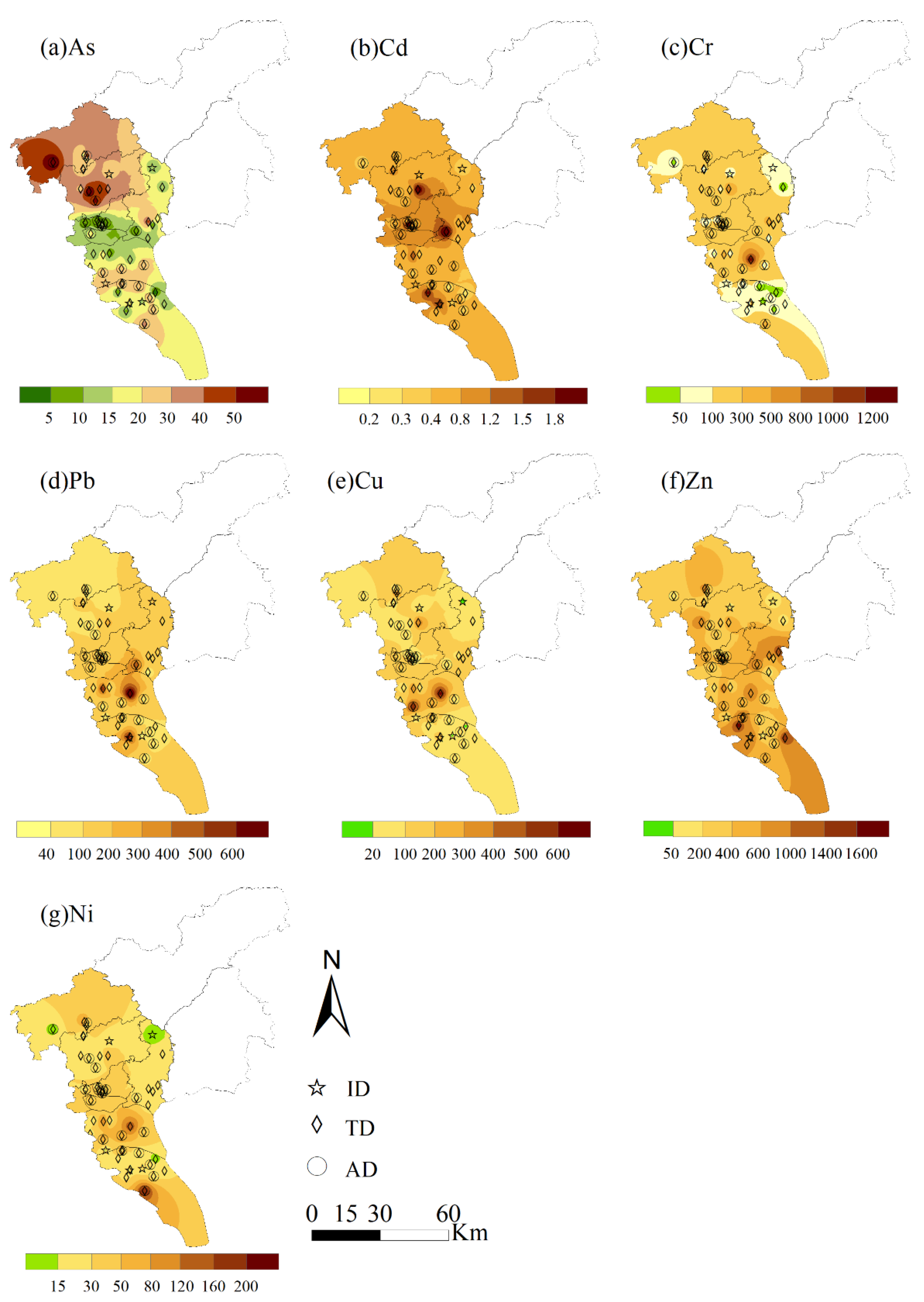

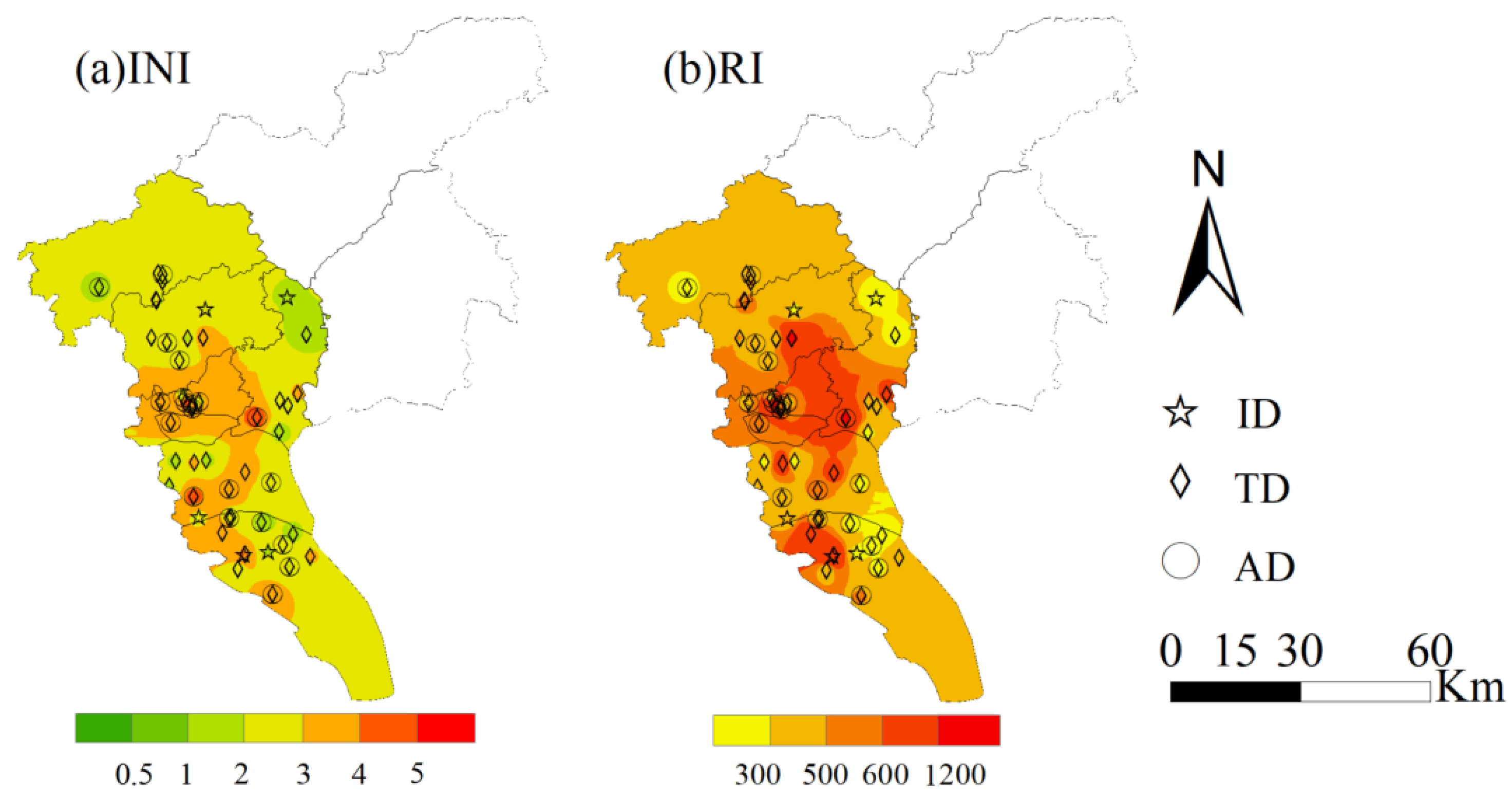
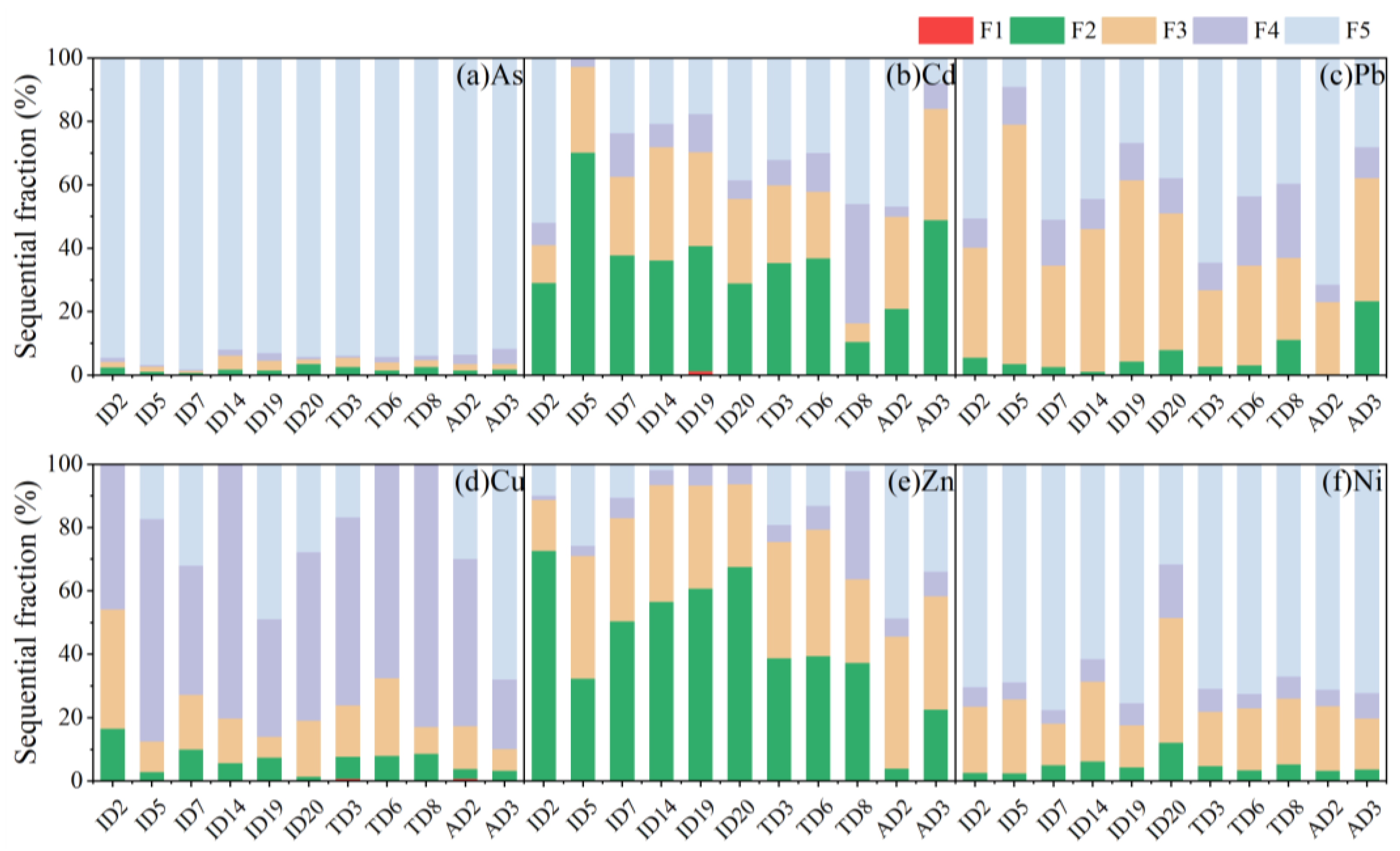

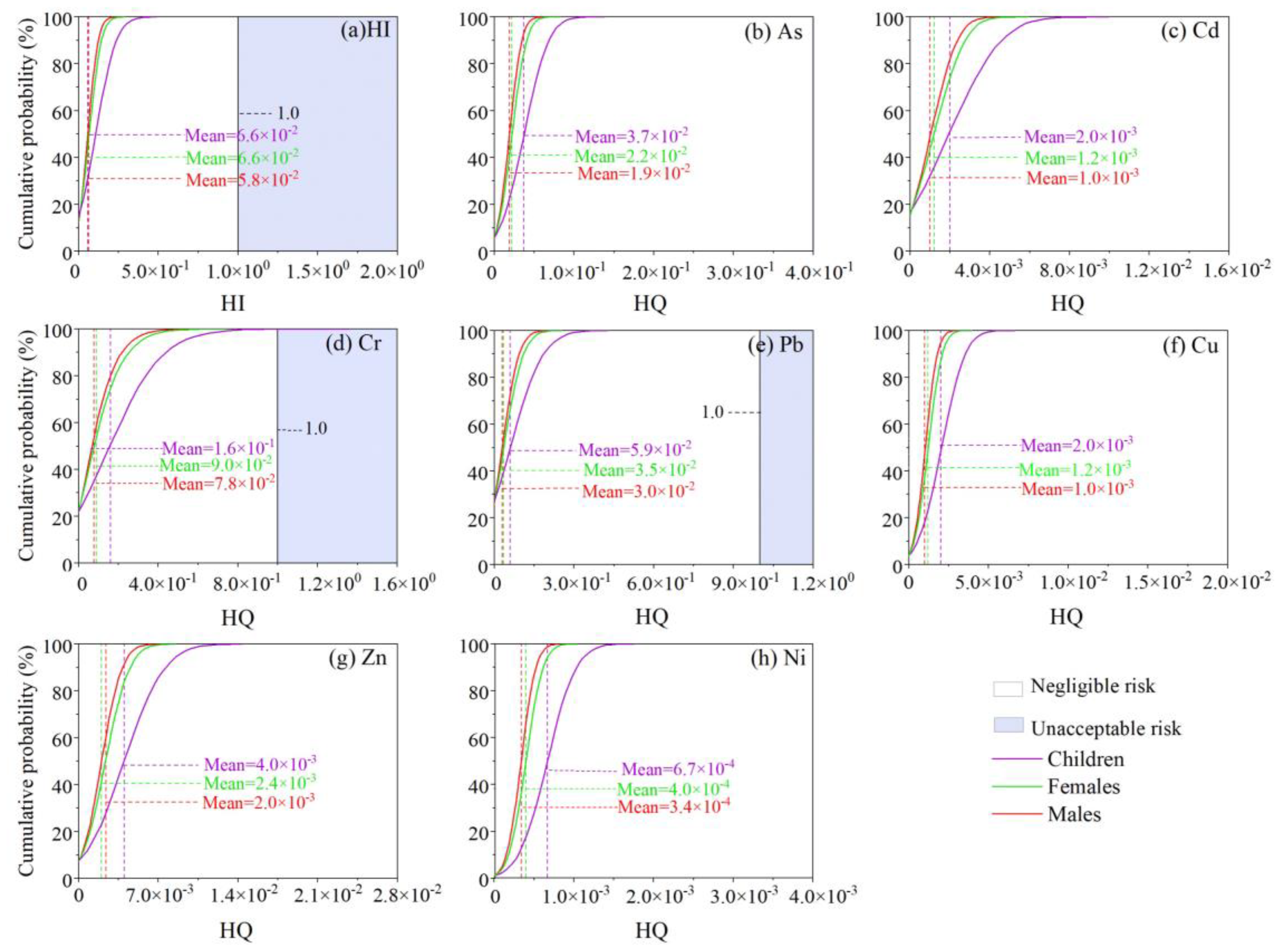
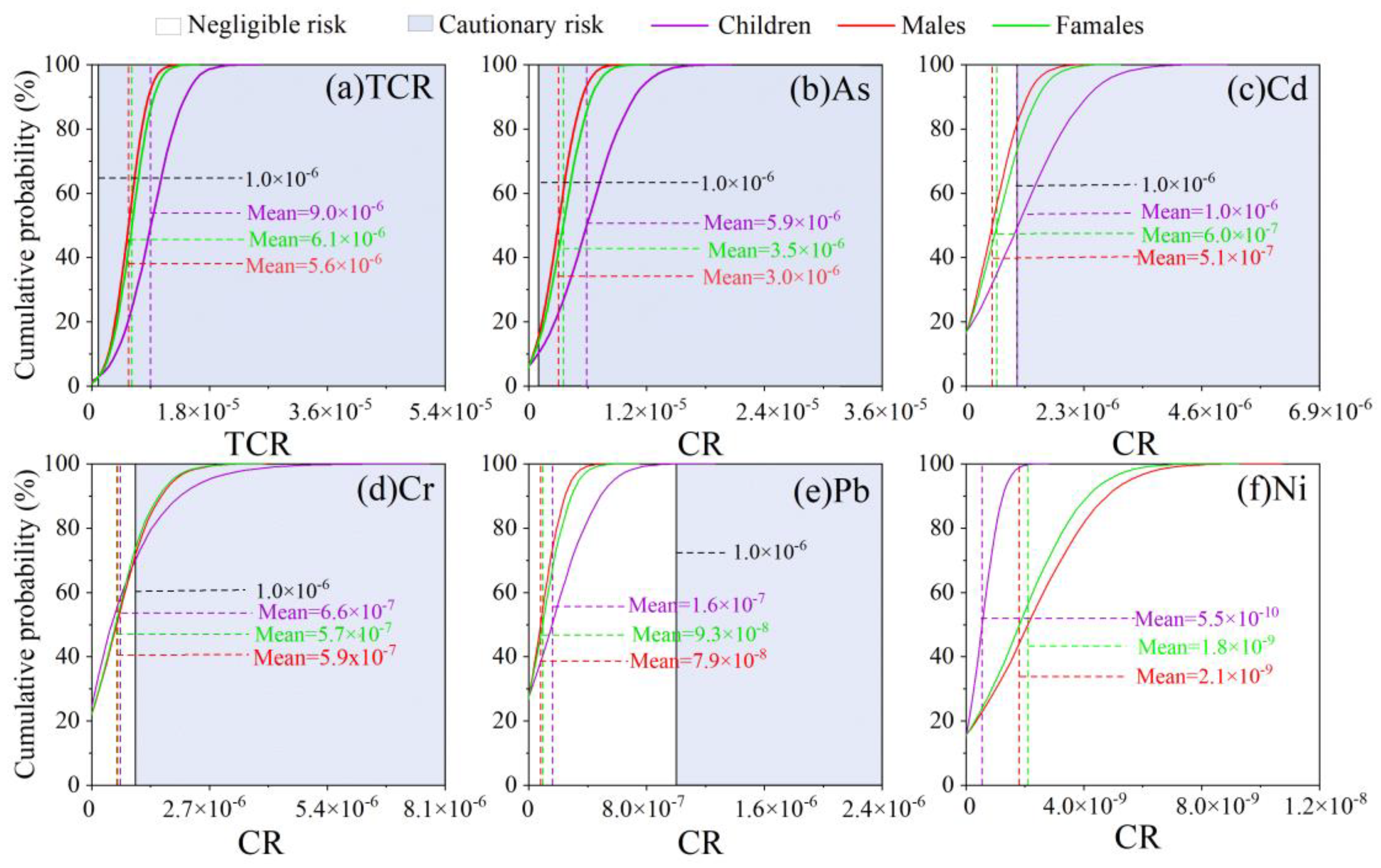
| Sample (n) | As | Cd | Cr | Pb | Cu | Zn | Ni | V | |
|---|---|---|---|---|---|---|---|---|---|
| Agricultural field (5) | Mean ± SD | 19.2 ± 5.7 | 0.74 ± 0.74 | 55.7 ± 16.6 | 219 ± 314 | 46.9 ± 55.8 | 143 ± 57.5 | 15.1 ± 3.6 | 41.6 ± 6.4 |
| Median | 22.8 | 0.43 | 50.5 | 147 | 139 | 460 | 32.0 | 44.5 | |
| Range | 12.8–23.8 | 0.31–2.05 | 35.2–73.5 | 77.4–259 | 45.9–171 | 236–558 | 24.9–46.0 | 34.2–47.3 | |
| Industrial park (23) | Mean ± SD | 18.4 ± 12.6 | 0.74 ± 0.52 | 200 ± 266 | 166 ± 177 | 133 ± 154 | 640 ± 493 | 34.8 ± 33.0 | 37.3 ± 11.1 |
| Median | 14 | 0.54 | 98.5 | 99.8 | 67.0 | 588 | 24.7 | 37.5 | |
| Range | 1.7–50.4 | 0.22–2.27 | 24.1–1260 | 29.9–806 | 16.2–625 | 46.9–1770 | 8.0–152 | 15.14–63.9 | |
| Traffic road (20) | Mean ± SD | 25.1 ± 18.3 | 0.72 ± 0.72 | 116 ± 71.9 | 115 ± 90.9 | 116 ± 125 | 368 ± 166 | 41.2 ± 40.7 | 41.0 ± 13.1 |
| Median | 21.7 | 0.48 | 106 | 79.6 | 86.1 | 332.2 | 31 | 40.0 | |
| Range | 4.7–61.2 | 0.23–3.14 | 34.4–347 | 47.1–440 | 23.8–599 | 162–761 | 10.7–201 | 18.3–61.8 | |
| Background | 17.4 | 0.06 | 50.5 | 36.0 | 17.0 | 47.3 | 14.4 | 70.7 |
| Road Dust | Population | Mean | Standard Deviation | 95% |
|---|---|---|---|---|
| Total content | Children | 6.1 × 10−1 | 3.5 × 10−1 | 1.2 |
| Adult women | 3.1 × 10−1 | 2.1 × 10−1 | 6.9 × 10−1 | |
| Adult men | 2.6 × 10−1 | 1.8 × 10−1 | 5.9 × 10−1 | |
| Bioaccessible content | Children | 6.6 × 10−2 | 1.1 × 10−1 | 2.7 × 10−1 |
| Adult women | 6.6 × 10−2 | 6.1 × 10−2 | 1.7 × 10−1 | |
| Adult men | 5.8 × 10−2 | 5.2 × 10−2 | 1.4 × 10−1 |
| Road Dust | Population | Mean | Standard Deviation | 95% |
|---|---|---|---|---|
| Total content | Children | 4.3 × 10−5 | 3.4 × 10−5 | 1.0 × 10−4 |
| Adult women | 2.3 × 10−5 | 1.9 × 10−5 | 5.9 × 10−5 | |
| Adult men | 2.0 × 10−5 | 1.7 × 10−5 | 5.0 × 10−5 | |
| Bioaccessible content | Children | 9.0 × 10−6 | 4.2 × 10−6 | 1.6 × 10−5 |
| Adult women | 6.1 × 10−6 | 2.6 × 10−6 | 1.0 × 10−6 | |
| Adult men | 5.6 × 10−6 | 2.4 × 10−6 | 9.5 × 10−6 |
Publisher’s Note: MDPI stays neutral with regard to jurisdictional claims in published maps and institutional affiliations. |
© 2022 by the authors. Licensee MDPI, Basel, Switzerland. This article is an open access article distributed under the terms and conditions of the Creative Commons Attribution (CC BY) license (https://creativecommons.org/licenses/by/4.0/).
Share and Cite
Tang, F.; Li, Z.; Zhao, Y.; Sun, J.; Sun, J.; Liu, Z.; Xiao, T.; Cui, J. Geochemical Contamination, Speciation, and Bioaccessibility of Trace Metals in Road Dust of a Megacity (Guangzhou) in Southern China: Implications for Human Health. Int. J. Environ. Res. Public Health 2022, 19, 15942. https://doi.org/10.3390/ijerph192315942
Tang F, Li Z, Zhao Y, Sun J, Sun J, Liu Z, Xiao T, Cui J. Geochemical Contamination, Speciation, and Bioaccessibility of Trace Metals in Road Dust of a Megacity (Guangzhou) in Southern China: Implications for Human Health. International Journal of Environmental Research and Public Health. 2022; 19(23):15942. https://doi.org/10.3390/ijerph192315942
Chicago/Turabian StyleTang, Fei, Zhi Li, Yanping Zhao, Jia Sun, Jianteng Sun, Zhenghui Liu, Tangfu Xiao, and Jinli Cui. 2022. "Geochemical Contamination, Speciation, and Bioaccessibility of Trace Metals in Road Dust of a Megacity (Guangzhou) in Southern China: Implications for Human Health" International Journal of Environmental Research and Public Health 19, no. 23: 15942. https://doi.org/10.3390/ijerph192315942
APA StyleTang, F., Li, Z., Zhao, Y., Sun, J., Sun, J., Liu, Z., Xiao, T., & Cui, J. (2022). Geochemical Contamination, Speciation, and Bioaccessibility of Trace Metals in Road Dust of a Megacity (Guangzhou) in Southern China: Implications for Human Health. International Journal of Environmental Research and Public Health, 19(23), 15942. https://doi.org/10.3390/ijerph192315942








